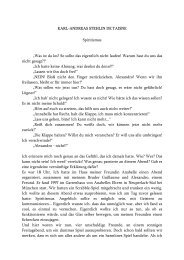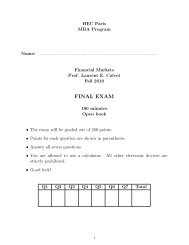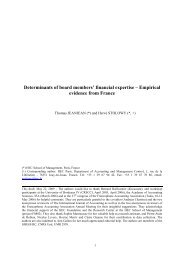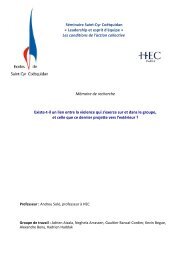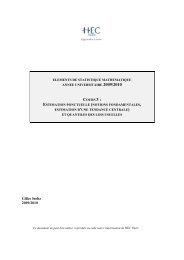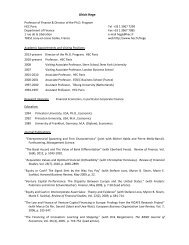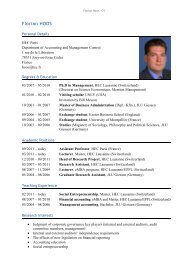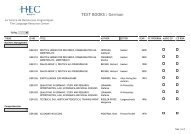Multifractality of US Dollar/Deutsche Mark Exchange Rates - Studies2
Multifractality of US Dollar/Deutsche Mark Exchange Rates - Studies2
Multifractality of US Dollar/Deutsche Mark Exchange Rates - Studies2
You also want an ePaper? Increase the reach of your titles
YUMPU automatically turns print PDFs into web optimized ePapers that Google loves.
empirical work in Section 5. The concept <strong>of</strong> Hölder exponent is essential. The local Hölder exponent,<br />
α(t), measures the local regularity <strong>of</strong> a process:<br />
X(t, △t) ∼ (△t) α(t)<br />
for all t, andas△t → 0. (7)<br />
In a standard Itô diffusion, the local variation is always proportional to (△t) 1/2 . The most common<br />
way to break this local scaling law is to introduce a jump component, which is akin to a local scaling<br />
rule <strong>of</strong> the form (△t) 0 .<br />
Multifractal processes generate variety in local regularity while filling the gaps between locally<br />
(△t) 1/2 and (△t) 0 behavior. Multifractal processes contain a multiplicity <strong>of</strong> local Hölder exponents.<br />
One might expect this diversity to result in unstructured behaviors. On the contrary, knitting<br />
together sets <strong>of</strong> points with different Hölder exponents requires a particular kind <strong>of</strong> structure,<br />
which is the topic <strong>of</strong> the two theoretical papers MFC and CFM.<br />
The multifractal spectrum is the main tool for describing the distribution <strong>of</strong> Hölder exponents.<br />
The following section reviews three subtly different interpretations. Section 4.2 provides a heuristic<br />
for estimating the multifractal spectrum via a Legendre transform <strong>of</strong> the scaling function. Finally,<br />
Section 4.3 reviews some basic facts about the multifractal spectrum that are useful in empirical<br />
work.<br />
4.1 Three Interpretations <strong>of</strong> the Multifractal Spectrum<br />
The multifractal spectrum is a function f(α) ≤ 1, that may be defined on any subset <strong>of</strong> the real<br />
line. The domain can be thought <strong>of</strong> as a space <strong>of</strong> Hölder exponents when α ≥ 0. (Thisistheonly<br />
case considered in the present paper.) 17 The goal <strong>of</strong> the multifractal spectrum is to describe the<br />
distribution <strong>of</strong> local Hölder exponents in a multifractal process. The most natural place to begin<br />
this investigation is with the standard frequency renormalization <strong>of</strong> probability theory. Partitioning<br />
time into a grid with increments <strong>of</strong> size △t = b −k , we define the coarse Hölder exponents,<br />
αk(t) =<br />
ln X[t, ∆t]<br />
.<br />
ln ∆t<br />
By increasing k we proceed to the limit △t → 0, and may expect that the frequency histogram <strong>of</strong><br />
coarse Hölder exponents will converge to the frequency distribution <strong>of</strong> Local Hölder exponents. This<br />
17 The case α



